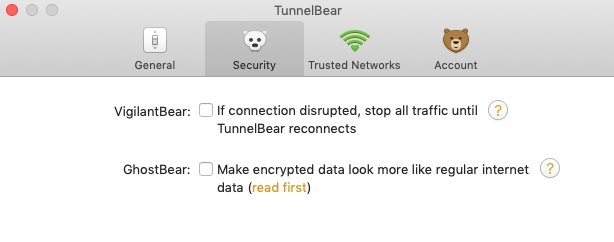As we find ourselves on our computers more and more when we’re traveling, I’ve tried to keep up with protecting our data. Connecting to Wi-Fi networks is one of our actions that carries a high risk, so we always try to use a VPN when on a public connection. We use TunnelBear VPN as it has a simple-to-use interface and provides the security we need. Given that our work isn’t anything top secret, having any level of protection makes us a less attractive target.
I had a frustrating time using TunnelBear VPN on a flight that used GoGo as the wireless internet provider. When I connected to the Wi-Fi and turned on my VPN, I was disconnected from the network. When I turned off the VPN, I reconnected. If I turned the VPN back on, I was instantly kicked off the network—EVERY SINGLE TIME!
This wasn’t a problem with being unable to log into the Wi-Fi network. I’ve covered in this post what to do if that happens.
I couldn’t do any troubleshooting during the flight, so I left the VPN off and didn’t do anything online that I’d worry about anyone seeing. That’s not a long-term solution, so I researched and found out this is an issue with public Wi-Fi networks.
With a basic Google search, I found the article “What to do if your VPN is blocked.” It quickly goes into techspeak about DPI, ports, and proxies, but what I found interesting was that it’s still possible to use a VPN even if the network doesn’t want you to.
But here’s the key: If you can disguise your VPN traffic as regular web browser traffic, you can make it impossible for a network to block your VPN (unless they’re willing to block all https browser traffic. Not likely).
If that’s true, can I do this with TunnelBear, or would I need to look for a different provider?
I went to the TunnelBear help page and found an answer to my problem. It doesn’t go into the tech talk of how it works, but it seems to be precisely what was mentioned in the article above.
What is GhostBear?
GhostBear makes your encrypted data less detectable to governments, businesses, and ISPs. It does this by making VPN traffic less detectable on your network, making it harder to block. GhostBear is currently available on our Windows, macOS (v4), and Android apps. GhostBear is not currently available for iOS or macOS (v5).
Little did I know that options I never knew existed were hidden in TunnelBear’s Settings> Preferences menu.

Right there is the option to turn on GhostBear. They advise you not to turn on this option unless you have to because it will slow down your connection. I’m not sure how much slower we’re talking about, but if it’s the only thing I can do to stay protected while on a public network, it’s worth the hassle.
I searched for the several major VPN products out there (NordVPN, PureVPN, CyberGhost VPN, ExpressVPN, personalVPN) and found that all of them offer some stealth mode that gets through network VPN blocking firewalls.
Final Thoughts
It was nice to see that my problem staying connected to a Wi-Fi network while using my VPN was a known issue. Even better, the solution was as simple as checking a box.
Want to comment on this post? Great! Read this first to help ensure it gets approved.
Want to sponsor a post, write something for Your Mileage May Vary, or put ads on our site? Click here for more info.
Like this post? Please share it! We have plenty more just like it and would love it if you decided to hang around and sign up to get emailed notifications of when we post.
Whether you’ve read our articles before or this is the first time you’re stopping by, we’re really glad you’re here and hope you come back to visit again!
This post first appeared on Your Mileage May Vary

6 comments
Super helpful. I use GoToMyPC, but this makes me think that TunnelBear may be worth a look.
Very interesting. I use PIA, but will definitely research if they offer this option!
I’m a Surfshark user, and I’m glad I never had this issue of when I get kicked out from the network. Although a friend of mine uses TunnelBear and was complaining to me about this issue, I will definitely share this article with him.
helpful truly, but the free version was not enough for me so I in the end I switched to nordvpn, yet only on my PC and laptop. My phone is still on TB
[…] WHAT TO DO WHEN CONNECTING TO A VPN KICKS YOU OFF THE NETWORK – YMMV […]
Tunneling your traffic through someone else’s network does not make it “secure”. If you want to connect to your network or workplace you’re better off hosting your own VPN. Only a fool would use third party for such practices & truly feel secure. People seem to forget these advertised VPNs are run by corporations who are legally obligated to follow local and international law. The more they make the stronger that obligation becomes. These same providers can also easily manipulate your traffic if they so choose. Don’t NOT blindly trust Tom , Dick and Harry to hide what you’re doing on the internet if you’re doing something that could make Sam knock. About the only thing third party VPNs are good for is torrenting. There may an exception for those living in repressed nations where said VPN is operating outside jurisdiction but that’s pretty much it.